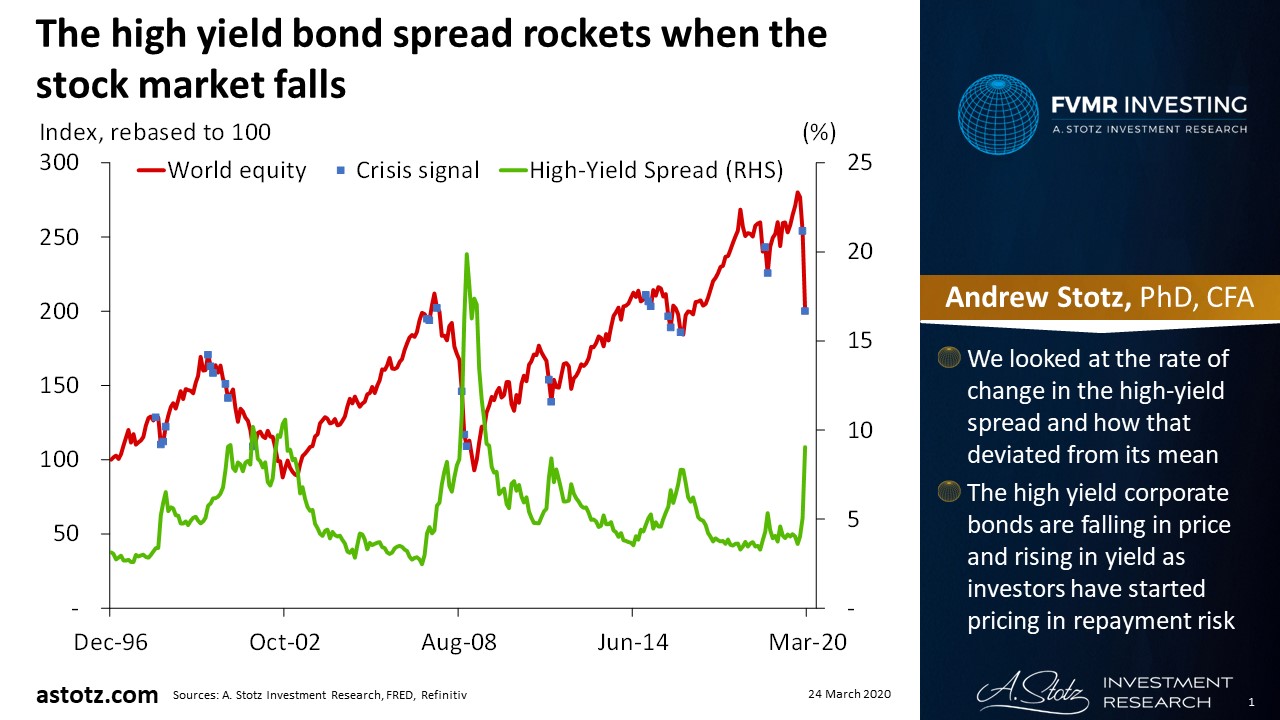When Bonds Are No Longer the Safe Haven They Use to Be
Recently, we read an interesting research piece called Crisis investing: Maximize returns during market panics. In the report, Dan Rasmussen and his team at Verdad looked into the high-yield spread, among other things:
“When investors and lenders panic, they reduce new lending and new investment as they attempt to de-risk their balance sheets. In a famous paper, Ben Bernanke labeled this the ‘financial accelerator’: economic shocks cause investors and lenders to panic and stop new lending and investing. Firms that rely on external financing reduce their discretionary spending, and weaker firms go bankrupt, all of which reflexively feeds back into aggregate economic activity. During recessions, the high-yield spread spikes upward and default rates soar. This stress rewards companies that are profitable and cash generative, while weak firms and companies that are investing heavily and burning cash struggle and often go bankrupt.”
Spikes in the high-yield spread overlap with economic recessions
The research highlights that prior economic recessions and periods that “reflected high degrees of uncertainty and fear in the markets” have overlapped with spikes in the high-yield spread. So, our team set out to do some testing of our own related to the high-yield spread to see what we could learn from it with regards to stock market cycles.
The high yield bond spread rockets when the stock market falls
Rather than looking at the absolute level of the high-yield spread, and deviation from its average, we looked at the rate of change in the high-yield spread and how that deviated from its historical mean.
When this measure passes a certain threshold, which is shown by the blue dots in the chart below, we can see that we’re either about to see a fall in the stock market or we’re in the falling market already. The chart below shows that the high yield corporate bonds are falling in price and rising in yield as investors have started pricing in repayment risk.

Bonds are not risk-free, not even government bonds
As bonds are often used to reduce portfolio risk, you do also need to realize that corporate bonds can lose their value if businesses are going bankrupt or default on their payments. Government bonds can also lose their value as countries default on their debt, which we, for example, saw in Europe in 2011, but the risk of that is generally lower.
When the stock market crashes shift from corporate bonds to government bonds
The spike in the high-yield spread is probably just the beginning, and the gap went as high as 20% in the 2008 Global Financial Crisis. The market is anticipating that the measures taken to contain the COVID-19 outbreak are going to have a significant negative impact on businesses.
Interest rate risk on bonds increases with maturity
Central banks have been changing interest rates around the world. Interest rates have an inverse relationship with bond price, i.e., if interest rates go down, bond prices go up. Therefore, rate cuts can often lead to bond funds gaining in value. Bonds with longer maturity are more sensitive to changes in interest rates. So, if you want to avoid an adverse impact on your bond investments in times when central banks are likely to intervene, you may consider holding shorter-term bonds rather than long maturities.
Foreign bonds, means you also bear FX risk
Since government bonds, in general, have a low yield, and short-term bonds in particular, currency movements can have a material impact on investor returns. Adverse currency moves can eat up all of your return, sometimes even more.
Local, short-term government bonds in stable countries can reduce risk
Therefore, for many investors, the safest bond alternative in times of high volatility and adverse economic conditions is short-term government bonds in their home country, assuming the government is stable and not too heavily indebted.
The All Weather Strategy is available in Thailand through FINNOMENA, follow updates of the strategy here. Please note that this post is not investment advice and should not be seen as recommendations. Also, remember that backtested or past performance is not a reliable indicator of future performance.
DISCLAIMER: This content is for information purposes only. It is not intended to be investment advice. Readers should not consider statements made by the author(s) as formal recommendations and should consult their financial advisor before making any investment decisions. While the information provided is believed to be accurate, it may include errors or inaccuracies. The author(s) cannot be held liable for any actions taken as a result of reading this article.
